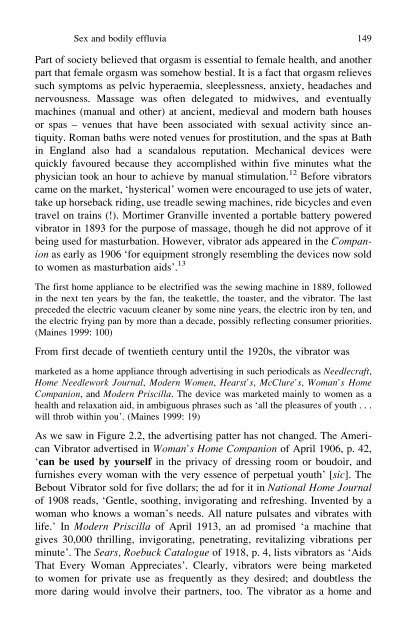Forbidden Words: Taboo and the Censoring of Language
Forbidden Words: Taboo and the Censoring of Language
Forbidden Words: Taboo and the Censoring of Language
Create successful ePaper yourself
Turn your PDF publications into a flip-book with our unique Google optimized e-Paper software.
Sex <strong>and</strong> bodily effluvia 149<br />
Part <strong>of</strong> society believed that orgasm is essential to female health, <strong>and</strong> ano<strong>the</strong>r<br />
part that female orgasm was somehow bestial. It is a fact that orgasm relieves<br />
such symptoms as pelvic hyperaemia, sleeplessness, anxiety, headaches <strong>and</strong><br />
nervousness. Massage was <strong>of</strong>ten delegated to midwives, <strong>and</strong> eventually<br />
machines (manual <strong>and</strong> o<strong>the</strong>r) at ancient, medieval <strong>and</strong> modern bath houses<br />
or spas – venues that have been associated with sexual activity since antiquity.<br />
Roman baths were noted venues for prostitution, <strong>and</strong> <strong>the</strong> spas at Bath<br />
in Engl<strong>and</strong> also had a sc<strong>and</strong>alous reputation. Mechanical devices were<br />
quickly favoured because <strong>the</strong>y accomplished within five minutes what <strong>the</strong><br />
physician took an hour to achieve by manual stimulation. 12 Before vibrators<br />
came on <strong>the</strong> market, ‘hysterical’ women were encouraged to use jets <strong>of</strong> water,<br />
take up horseback riding, use treadle sewing machines, ride bicycles <strong>and</strong> even<br />
travel on trains (!). Mortimer Granville invented a portable battery powered<br />
vibrator in 1893 for <strong>the</strong> purpose <strong>of</strong> massage, though he did not approve <strong>of</strong> it<br />
being used for masturbation. However, vibrator ads appeared in <strong>the</strong> Companion<br />
as early as 1906 ‘for equipment strongly resembling <strong>the</strong> devices now sold<br />
to women as masturbation aids’. 13<br />
The first home appliance to be electrified was <strong>the</strong> sewing machine in 1889, followed<br />
in <strong>the</strong> next ten years by <strong>the</strong> fan, <strong>the</strong> teakettle, <strong>the</strong> toaster, <strong>and</strong> <strong>the</strong> vibrator. The last<br />
preceded <strong>the</strong> electric vacuum cleaner by some nine years, <strong>the</strong> electric iron by ten, <strong>and</strong><br />
<strong>the</strong> electric frying pan by more than a decade, possibly reflecting consumer priorities.<br />
(Maines 1999: 100)<br />
From first decade <strong>of</strong> twentieth century until <strong>the</strong> 1920s, <strong>the</strong> vibrator was<br />
marketed as a home appliance through advertising in such periodicals as Needlecraft,<br />
Home Needlework Journal, Modern Women, Hearst’s, McClure’s, Woman’s Home<br />
Companion, <strong>and</strong> Modern Priscilla. The device was marketed mainly to women as a<br />
health <strong>and</strong> relaxation aid, in ambiguous phrases such as ‘all <strong>the</strong> pleasures <strong>of</strong> youth . . .<br />
will throb within you’. (Maines 1999: 19)<br />
As we saw in Figure 2.2, <strong>the</strong> advertising patter has not changed. The American<br />
Vibrator advertised in Woman’s Home Companion <strong>of</strong> April 1906, p. 42,<br />
‘can be used by yourself in <strong>the</strong> privacy <strong>of</strong> dressing room or boudoir, <strong>and</strong><br />
furnishes every woman with <strong>the</strong> very essence <strong>of</strong> perpetual youth’ [sic]. The<br />
Bebout Vibrator sold for five dollars; <strong>the</strong> ad for it in National Home Journal<br />
<strong>of</strong> 1908 reads, ‘Gentle, soothing, invigorating <strong>and</strong> refreshing. Invented by a<br />
woman who knows a woman’s needs. All nature pulsates <strong>and</strong> vibrates with<br />
life.’ In Modern Priscilla <strong>of</strong> April 1913, an ad promised ‘a machine that<br />
gives 30,000 thrilling, invigorating, penetrating, revitalizing vibrations per<br />
minute’. The Sears, Roebuck Catalogue <strong>of</strong> 1918, p. 4, lists vibrators as ‘Aids<br />
That Every Woman Appreciates’. Clearly, vibrators were being marketed<br />
to women for private use as frequently as <strong>the</strong>y desired; <strong>and</strong> doubtless <strong>the</strong><br />
more daring would involve <strong>the</strong>ir partners, too. The vibrator as a home <strong>and</strong>

















